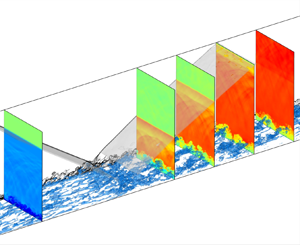Article contents
Post-shock turbulence recovery in oblique-shock/turbulent boundary layer interaction flows
Published online by Cambridge University Press: 24 April 2023
Abstract

The oblique shock impinging on the supersonic turbulent boundary layer leads to a mixing layer and the emergence of large-scale coherent structures within the interaction zone which leave significant velocity defect and turbulence amplification downstream. In the present study, we investigate the turbulence recovery in the post-shock region by exploiting direct numerical simulation data of the oblique-shock/turbulent boundary layer interaction flow at the incoming Mach number of  $2.28$ and the shock angle of
$2.28$ and the shock angle of  $33.2^\circ$, with special attention paid to the contribution of the mixing layer and large-scale structures to flow dynamics. For that purpose, we propose to split the mean velocity, Reynolds stresses and spanwise spectra into a canonical portion that is constructed according to the statistics of canonical turbulent boundary layers, and a mixing-layer-induced portion. We found that the hidden mixing layer grows with the boundary layer thickness and that the induced mean shear and Reynolds stresses decay at different rates. The mean velocity recovers to the canonical profiles at a distance of 13 boundary layer thicknesses downstream where the mixing-layer-induced mean shear ceases to have strong impacts. The recovery of Reynolds stresses requires 10 boundary layer thicknesses in the near-wall region but a much longer streamwise extent in the outer region due to the slow decay of large-scale motions. These large-scale motions superpose on the near-wall turbulence, intensifying the turbulent fluctuations, yet having a trivial impact on the skin friction, for the contribution of the mixing-layer-induced mean shear and Reynolds shear stress are balanced by the advection term. We further establish a simple physical model capable of approximately predicting the streamwise evolution of mixing-layer-induced mean shear and turbulent kinetic energy. This model suggests that the complete recovery of turbulence in the outer region requires a streamwise extent of approximately 50 boundary layer thicknesses.
$33.2^\circ$, with special attention paid to the contribution of the mixing layer and large-scale structures to flow dynamics. For that purpose, we propose to split the mean velocity, Reynolds stresses and spanwise spectra into a canonical portion that is constructed according to the statistics of canonical turbulent boundary layers, and a mixing-layer-induced portion. We found that the hidden mixing layer grows with the boundary layer thickness and that the induced mean shear and Reynolds stresses decay at different rates. The mean velocity recovers to the canonical profiles at a distance of 13 boundary layer thicknesses downstream where the mixing-layer-induced mean shear ceases to have strong impacts. The recovery of Reynolds stresses requires 10 boundary layer thicknesses in the near-wall region but a much longer streamwise extent in the outer region due to the slow decay of large-scale motions. These large-scale motions superpose on the near-wall turbulence, intensifying the turbulent fluctuations, yet having a trivial impact on the skin friction, for the contribution of the mixing-layer-induced mean shear and Reynolds shear stress are balanced by the advection term. We further establish a simple physical model capable of approximately predicting the streamwise evolution of mixing-layer-induced mean shear and turbulent kinetic energy. This model suggests that the complete recovery of turbulence in the outer region requires a streamwise extent of approximately 50 boundary layer thicknesses.
JFM classification
- Type
- JFM Papers
- Information
- Copyright
- © The Author(s), 2023. Published by Cambridge University Press
References
- 1
- Cited by





